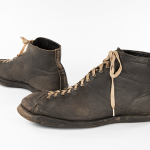Guest Post 2012, By Samantha Conover, plastics specialist
At the end of February I began a contractproject at the Bata Shoe Museum. My job is to go through the Western Fashion collection and survey, assess and identify any and all plastic components contained within. Many people are surprised to learn how prevalent plastics are within a museum setting. This is mainly due to the conception that plastics are a thoroughly modern material. In fact, plastics have been around for a lot longer than many people realize!
In order to best understand the role of plastics in the museum, I would like to offer a brief overview of plastics. A plastic is material that can be molded into shape. These materials are made up of polymers, long chains of repeating molecular units. Some plastics have polymer chains that are long and linear which allow for flexibility and movement. Other plastics have a three-dimensional network of cross-linked chains that allows for greater strength and hardness.
Plastics can be natural, semi-synthetic or fully synthetic. Natural plastics, such as amber, horn or shellac are materials found in nature that can be pressed into a new shape. Reacting natural substances with chemicals creates semi synthetic moldable materials like cellulose nitrate, casein or vulcanized rubber. Synthetic plastics are entirely human made.
The first semi-synthetic material to be created was vulcanized rubber. Natural rubber had been valued for years it’s flexibility and weather resistance but had problems becoming sticky in the summer and brittle in the winter. In 1839 Charles Goodyear discovered that by adding sulfur to rubber he could make the material more stable, strong and durable. Soon enough, this new form of rubber was used to line shoe soles and heels in order to provide shock absorption, like tires on a car.

In 1862 Alexander Parkes created “Parkesine” by reacting cellulose (from cotton linters) with nitric acids. This cellulose nitrate material was commonly used in a decorative manner and shaped and coloured in order to imitate expensive natural materials such as ivory and amber. Cellulose nitrate was often produced in films and sheets that could be shaped over a backing material. As I’ve gone through the Bata collection, I have discovered a wealth of shoe heels from the early 1900s and 1920s that have shiny black “lacquered” heels. Applying layers of resin to wood creates a lacquer finish, but the heels I’ve found appear to be one solid, shiny piece wrapped around a wooden base rather than a coating. I suspect that these heels may be covered with cellulose nitrate, and I intend to do some testing to find out!


In 1907 Leo Baekeland created the first fully synthetic material, the famous Bakelite. This innovation led to the synthesis of scores of new plastics throughout the 20th century. Modern materials were used in design to create new and intriguing effects. This Salvatore Ferragamo sandal from the 1940s uses nylon thread to give a spun silk effect that looks lighter than air. Although the strands are thin and translucent, the nylon material is resistant and strong. In the 1960s, Herbert Levine used PVC and acrylic to create clear loafers that exude space-age sophistication. PVC is important to this design because it can be made transparent and flexible, while acrylic looks like glass, but is much stronger and lighter.
As you can see, plastics have a long history. Because of important physical properties such as strength and resistance, and aesthetic qualities such as shine and transparency, plastics have been used by shoemakers in a myriad of ways. In my next blog I plan to discuss why it is important to identify and care for plastics in the museum. Despite their reputation of being indestructible, plastics don’t last forever and can degrade quite spectacularly!
If you are interested in learning more about plastics, I highly recommend the Plastics Historical Society website.
All images © 2012 Bata Shoe Museum



Very cool post! Thanks for giving us the insight from your perspective. Have come across the PHS before, but will be looking at that site differently now.
Love these designer shoes,they are so cut ! Christian Louboutin